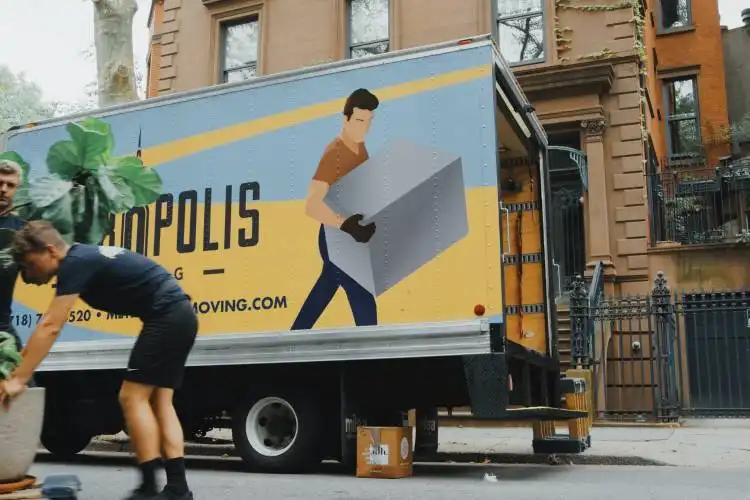Start a Delivery Service
Be the Driving Force Behind Daily Deliveries: Illuminate Lives and Profit from It!
| Updated


DELIVERY SERVICE
Ladies and gents, warm up your engines, because the business world is crying out for reliable delivery services! Think of a smooth operation where you fulfill people's needs at the tap of a button, transporting everything from precious family antiques to piping hot pizzas. This sort of venture primarily revolves around picking up and delivering items from point A to point B, often within a specific locality. One moment you'll be a personal Santa Claus delivering joy (or presents), the next, you're the essential lifeline of a busy office with documents. Dive into this venture and become the dependable link in the chain of supply and demand.
Jump to Business Plan
RELATED BUSINESS IDEAS
Browse ALL Rental & Delivery Services Business Ideas
Discover Your Perfect Domain
Unlock the door to your online success with our hand-picked selection of premium domain names. Whether you're starting a new venture or rebranding an existing one, the right domain can set the tone for your digital presence. Browse through our curated list, each with its unique potential to enhance your brand's visibility and credibility.
DELIVERY MINI BUSINESS PLAN
This a quick reality check to help you identify the strengths and weaknesses of your business concept before you dive in.
Business Idea: Delivery Service
Expected Percent Margin:
- Gross Margin: 20-30% (primarily due to fuel and vehicle maintenance costs)
- Net Profit Margin: 5-10% (taking into account wages, insurance, and other overheads)
Earnings Expectations:
- Daily Earnings: $150 - $300
- Weekly Earnings: $1,050 - $2,100
- Monthly Earnings: $4,500 - $9,000
- Annual Earnings: $54,000 - $108,000
Actions to Hit Those Numbers:
Fleet Management:
- Initial Investment: For a small delivery service starting with 2-3 delivery vehicles, expect to spend around $20,000 - $50,000.
- Maintenance: Regular vehicle maintenance to prevent unexpected breakdowns and fuel inefficiency.
Marketing and Customer Acquisition:
- Digital Marketing: Establish online presence via a company website and social media pages.
- Partnerships: Partner with local businesses in need of regular delivery service.
Service and Customer Experience:
- Reliability: Ensure fast, reliable service to get repeat customers.
- Driver Training: Train drivers in customer service and safe driving practices.
Cost Control:
- Route Optimization: Use route optimization software to decrease mileage and save on fuel costs.
- Insurance: Shop for the best insurance rates to protect your business and reduce overhead.
Business Operations:
- Working Hours: Depending on the market need, you might operate 12-24 hrs.
- Volume of Deliveries: Aim to make 15-25 deliveries per day per vehicle for profitable operations.
Keep in mind these are rough estimations and can significantly vary based on local market conditions, competitive landscapes, and your specific business tactics and strategies. Always do your own extensive market research and seek advice from professionals or consultants in the field.
NOT WHAT YOU HAD IN MIND? Here are more ideas



Browse ALL Rental & Delivery Services Business Ideas
Grab Your Business Website Name
Before you get caught up in the whirlwind of setting up your business, invest in a domain name. It's a small but significant step that lays the foundation for your brand and makes it easier for customers to find and trust you. Just like you wouldn't build a house without securing the land first, don't build a business without securing your domain name.
"Why? Can't that wait?" Here's why it shouldn't
Step 1: Determine if a Delivery Service is Right for You
Breakdown of Startup Expenses
When considering starting a delivery service, it is important to understand the startup expenses that will be necessary to get the business up and running. These expenses can include the cost of a vehicle, insurance, fuel, and any other necessary equipment. It is also important to consider the cost of any necessary licenses or permits. Additionally, it is important to consider the cost of any marketing materials and advertising that may be necessary to get the business off the ground.
Breakdown of Ongoing Expenses
In addition to startup expenses, it is important to consider the ongoing expenses that will be necessary to keep the business running. These expenses can include the cost of fuel, insurance, vehicle maintenance, and any other necessary supplies. It is also important to consider the cost of any licenses or permits that may need to be renewed periodically. Additionally, it is important to consider the cost of any marketing materials and advertising that may be necessary to keep the business running.
Examples of Ways to Make Money
When starting a delivery service, it is important to consider the various ways to make money. These can include charging a delivery fee, charging a flat rate for certain items, or charging a percentage of the total cost of the items being delivered. Additionally, it is important to consider any additional services that can be offered to customers, such as gift wrapping or assembly of items. It is also important to consider any discounts or promotions that can be offered to customers to encourage them to use the delivery service.
Step 2: Name Your Delivery Service
When naming your delivery service, it is important to keep a few things in mind. First, you want the name to be memorable, easy to spell, and easy to pronounce. It should also be unique, so that it stands out from other delivery services. Additionally, you want to make sure the name is relevant to the services you offer. You may also want to consider registering a domain name for your business. This will help customers find your website more easily.
Next, you should think about the type of logo you want to use. A logo is an important part of your business’s identity, and it should be something that is recognizable and memorable. You may want to consider hiring a professional designer to create a logo for you.
Finally, you should consider registering your business with the local government. This will help protect your business’s name and ensure that no one else can use it. Additionally, it will help you establish a legal entity for your business and give you access to certain tax benefits.
Step 3: Create a Business Plan
Outline Your Goals
When creating a business plan, it is important to outline your goals. This should include short-term and long-term goals. Short-term goals are goals that can be accomplished in a year or less, while long-term goals are goals that take more than a year to accomplish. It is important to be realistic when setting goals and to make sure that they are achievable. Additionally, it is important to set measurable goals so that you can track your progress.
Establish Your Target Market
When creating a business plan, it is important to establish your target market. This is the group of people that you will be marketing your delivery service to. It is important to research the demographics of your target market, such as age, gender, location, and income level. Additionally, it is important to research the needs of your target market and how your delivery service can meet those needs.
Analyze Your Competition
When creating a business plan, it is important to analyze your competition. This includes researching the other delivery services in your area and understanding their strengths and weaknesses. Additionally, it is important to research their pricing structure and their marketing strategies. By understanding your competition, you can create a plan to differentiate your delivery service and make it stand out from the competition.
Step 4: Obtain Licenses and Permits
Research Necessary Licenses and Permits
Before starting a delivery service, it is important to research the necessary licenses and permits that are required to operate the business. Depending on the type of delivery service, certain licenses and permits may be required. For example, if the delivery service is transporting goods, a commercial driver’s license may be required. Additionally, any type of delivery service may require a business license and permits to operate in the area. It is important to research the necessary licenses and permits to ensure that the business is operating legally.
Obtain Necessary Licenses and Permits
After researching the necessary licenses and permits, the next step is to obtain them. Depending on the type of delivery service, the process of obtaining the necessary licenses and permits may vary. For example, if the delivery service is transporting goods, the business owner may need to take a written and driving test to obtain a commercial driver’s license. Additionally, the business owner may need to fill out paperwork and pay a fee to obtain a business license and other necessary permits. It is important to make sure that all necessary licenses and permits are obtained before starting the delivery service.
Step 5: Choose Your Delivery Method
Consider Your Delivery Options
When deciding on the best delivery method for your business, you should consider the types of items you will be delivering, the distance you will need to travel, and the cost of delivery. For example, if you are delivering large items, you may want to consider using a truck or van. If you are delivering smaller items, you may want to consider using a bike or scooter. Additionally, if you are delivering items over a long distance, you may want to consider using a courier service.
Choose the Best Delivery Method
Once you have considered your delivery options, you should choose the best delivery method for your business. When making this decision, you should consider the cost of delivery, the speed of delivery, and the customer experience. For example, if you are delivering items quickly and cost is not a major factor, you may want to use a courier service. If you are delivering items over a long distance, you may want to use a truck or van. Additionally, if you are delivering items to customers’ homes, you may want to consider using a bike or scooter for a more personal touch.
When choosing the best delivery method, you should also consider the safety of your delivery personnel. If you are using a bike or scooter, you should make sure that your delivery personnel have the proper safety gear, such as a helmet, reflective clothing, and lights. Additionally, if you are using a truck or van, you should make sure that your delivery personnel have the proper training and licensing.
Step 6: Find Suppliers
Research Suppliers
When starting a delivery service, it is important to find reliable suppliers that can provide the necessary products or services. Researching suppliers should include looking into their reputation, quality of their products, and the cost of their services. It is also important to consider the delivery time and the payment terms of each supplier. Additionally, it is important to research the customer service of each supplier and to make sure they are willing to answer any questions or concerns that may arise.
Negotiate Prices
Once the right suppliers have been identified, it is important to negotiate prices. Negotiating prices can involve getting the best possible deal on the products or services that are needed. This can include looking into discounts, special offers, and bulk orders. It is also important to consider the delivery fees and any additional fees that may be associated with the supplier. Additionally, it is important to consider the payment terms and to make sure that the supplier is willing to work with the delivery service.
Step 7: Market Your Delivery Service
Create a Website
In order to reach the widest possible audience, it is essential to create a website for your delivery service. This website should include information about the services you offer, the areas you serve, and contact information. You should also include customer reviews and testimonials to help build trust. Additionally, you can use the website to showcase any special offers or discounts you may have. Finally, you should make sure the website is optimized for mobile devices so that customers can easily access it on the go.
Utilize Social Media
Social media is a great way to spread the word about your delivery service. You can create a business page on popular platforms such as Facebook, Twitter, and Instagram. This will allow you to share updates about your services, post photos of your deliveries, and interact with customers. Additionally, you can use social media to run special promotions and offer discounts to followers.
Advertise Locally
Advertising locally is a great way to reach potential customers in your area. You can use flyers, posters, and billboards to spread the word about your delivery service. Additionally, you can partner with local businesses to offer discounts to their customers. You can also consider sponsoring local events or offering discounts to members of local organizations. Finally, you can use local newspapers and radio stations to advertise your services.
Step 8: Hire Employees
Determine Employee Needs
Before hiring employees, it is important to determine what kind of employees you need. Consider the type of delivery service you are offering and the size of your business. Are you offering a delivery service for restaurants? Are you delivering packages? Are you delivering food? Depending on the type of delivery service you are offering, you may need to hire drivers, delivery personnel, customer service representatives, and other staff.
Post Job Listings
Once you have determined the type of employees you need, you can start posting job listings. Consider using job boards, social media, and other online platforms to reach potential employees. Make sure to include a detailed job description and list the qualifications and experience you are looking for in a candidate.
Interview and Hire Employees
After you have posted the job listings, you can start the interview process. Make sure to ask questions that will help you determine if the candidate is a good fit for the job. Consider asking questions about their experience, their qualifications, and their availability. Once you have found the right candidate, you can offer them the job and start the onboarding process.
Step 9: Track Your Progress
Set Performance Goals
Before you start your delivery service, it is important to set performance goals. These goals should be specific, measurable, achievable, relevant, and time-bound. For example, you could set a goal of delivering a certain number of packages in a certain amount of time. You should also set goals for customer satisfaction, such as responding to customer inquiries within a certain time frame.
Monitor Performance
Once you have set your performance goals, it is important to monitor your progress. This can be done by tracking metrics such as the number of deliveries made, customer satisfaction ratings, and the amount of money earned. You should also track any changes in the market that could affect your business, such as changes in customer demand or new competitors entering the market. By monitoring your performance, you can make adjustments to your business model as needed.
EXPLORE MORE CATEGORIES
Browse ALL Business Idea Categories
TAKE THE NEXT STEPS










